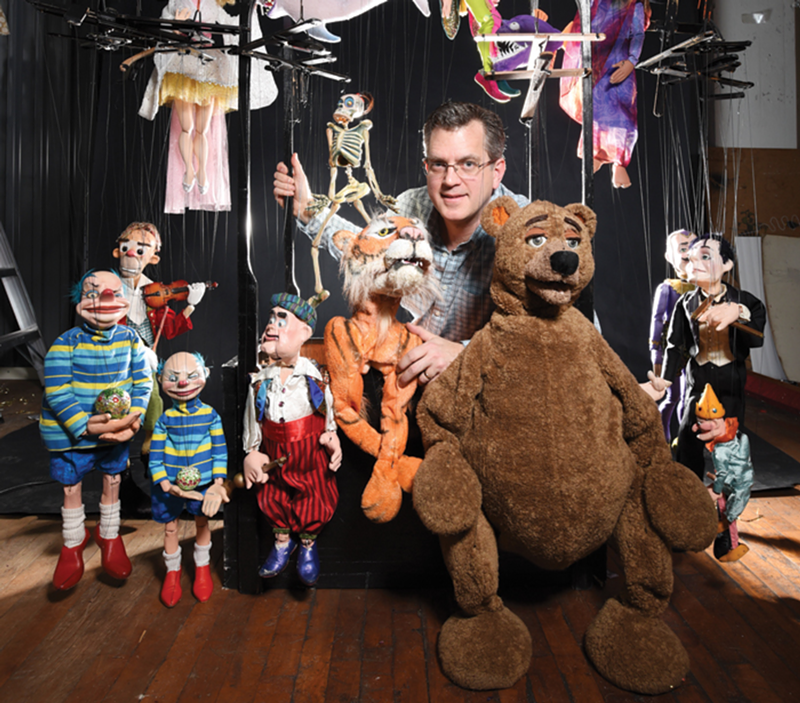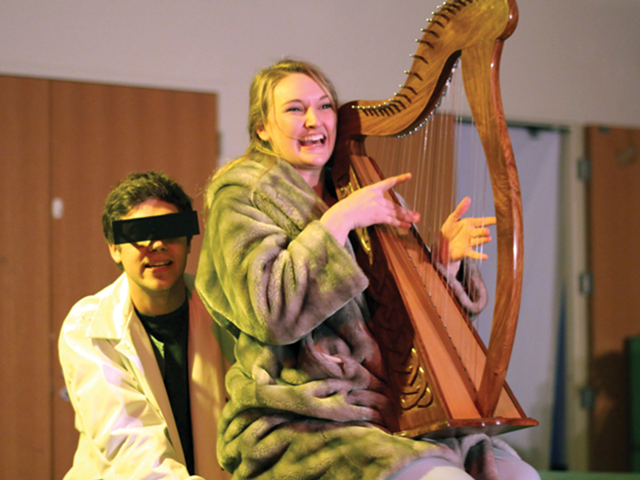T
he art of puppetry is a form of human communication almost as old as storytelling itself, using marionettes and representational figures to tell the same poignant, comedic and inventive tales that actors do onstage.
Since ancient Greece and Egypt, every culture has had its own version of puppet theater, from Iran’s decades-old international Tehran Mobarak Puppet Festival to Japan’s traditional Bunraku style, where multiple visible puppeteers manipulate a single puppet, to England’s cultural touchstone of Punch and Judy, a marionette show that dates back to the 17th century but is still widely performed today.
But it wasn’t until the early 20th century that puppets became ubiquitous in America. The Puppeteers of America, a national nonprofit organization dedicated to celebrating puppetry, was founded in 1937. Between the late 1940s and 1970s, puppetry mushroomed on a national level, with children’s television shows Howdy Doody, Lamb Chop, Sesame Street, The Muppets and H.R. Pufnstuf all utilizing puppets as a main component of their storytelling. During the ’80s, kids shows like Fraggle Rock again captured our interest, and in the ’90s and 2000s, the twistedness of adult-oriented puppet series like Wonder Showzen, Team America: World Police and Broadway’s Avenue Q, plus the brightly inventive kids show Yo Gabba Gabba!, with DJ Lance Rock and his five come-to-life toy friends, continued taking the form to new heights.
Puppetry has also been part of Cincinnati’s local pop culture dating back to the 1960s, when Larry Smith paved the way with a kids show on WXIX featuring puppets named Hattie the Witch and Snarfie the Dog. Smith founded the Cincinnati Area Puppetry Guild in 1971. More than 40 years later, the organization is still promoting puppetry in the city.
But for all the charm and historic significance a well-performed puppet show brings to the table, the industry must still at times fight the stigma created by movies like Puppet Master or Chucky, and people’s fear of puppets (pupaphobia).
“It’s unsettling, but there’s a lot more to puppetry than that aspect to it,” says Kevin Frisch, founder and puppeteer at The Frisch Marionette Company.
Frisch says live performances can be so much more than a “puppet show,” delving into serious topics and engaging with kids and adults alike. He recounts a time he saw a show about a guinea pig dying and was moved to tears.
“That’s how good puppetry can be,” he says. “A lot of what you see on TV is sort of an ode to Chucky — the scary thing, the creepy thing or looking for a gag, because I don’t think people see enough of the good stuff.”
It doesn’t take long for audiences to connect with live performances, and in Cincinnati there are plenty of professionals at the ready, including local puppeteering companies Madcap Puppets, the aforementioned Frisch Marionette Company and Wump Mucket Puppets.
Madcap’s mission to explore artistic forms and social concerns with puppetry, music and acting in order to educate and engage with a diverse audience dates all the way back to 1981.
The Frisch Marionette Company (formed in 1995) and new-ish local puppetry group Wump Mucket Puppets (2010), a colorful collection of UFOs and strange beasts who sing and tell silly stories, have set the stage for a new generation of puppeteers in the Cincinnati scene, creating innovative performances that will again forward the craft sooner rather than later.
“People say it’s a dying art form,” Frisch says. “It’s not really a dying art form, it’s always in a permanent state of potential. There’s so much potential in it. I’m not sure a lot of people in it even understand the potential with the craft.”
Welcome to Vent Haven
Ventriloquism, a subcategory of puppetry where a puppeteer throws his or her voice to make it appear as if it’s coming from a hand-manipulated “dummy” or puppet, is a wellspring of horror potential — remember R.L. Stine’s Goosebump’s book Night of the Living Dummy? It probably also doesn’t help that Neil Patrick Harris recently played a troubled ventriloquist in this season’s American Horror Story: Freak Show.
But comedian Jeff Dunham (The Jeff Dunham Show) and his cast of mildly offensive characters are probably the most mainstream example of the ventriloquism act today — they only thing scaring people about his dummies is the multimillion dollar paycheck they’re garnering for him.
But just like the rest of puppeteering, ventriloquism has a deep and rich history, and the Tristate is home to the only museum in the world dedicated to the art. The Vent Haven Museum houses hundreds of the life-like dummies or figures in its Fort Mitchell, Ky., museum, along with an extensive library of “vent” books, photographs and other ephemera about the stagecraft.
“That’d be a nightmare for a lot of people, walking into a room full of staring dummies,” Frisch says about a recent visit to Vent Haven. “But for me, I was in heaven. I thought it was great.”
Lisa Sweasy, the museum’s curator since 2000, says people often react to the sheer number of dummies in the museum — more than 800 — in addition to their intricately crafted faces.
Sweasy, Vent Haven curator since 2000, says she is amazed at the size and scope of the collection left by W.S. Berger, a Cincinnati native, avid ventriloquist figure collector, former president of the International Brotherhood of Ventriloquists and former publisher of vent magazine The Oracle. The museum houses his intact collection.In 2013, photographer Matthew Rolston released an entire book on Vent Haven’s dummies called Talking Heads: The Vent Haven Portraits.
“When I saw the faces at Vent Haven, I thought it was the best lineup, the best casting call, I had ever seen,” he told CityBeat in 2012.
Sweasy credits the aforementioned comedian Jeff Dunham with breaking down major barriers for contemporary puppeteers. “Jeff’s career has been amazing and his fame is worldwide,” she says. “His fan base spans from 10-year-olds to 80-year-olds. Most tourists who visit here ask about Jeff and what we have of his. No ventriloquist since Edgar Bergen has been as well known in the entertainment world as Jeff is today.”
Local puppeteers
Perception is a big part of puppetry — Are puppets creepy? Are puppets a form of entertainment for adults or just kids? — and local puppeteers are trying to change people’s view of the craft.
Hand-built puppets are the most recognizable form found in kids shows. Ryan Moore, owner of Ryan Moore Puppetry, unexpectedly fell into the field three years ago when his young daughter became obsessed with Sesame Street. As any good dad would do, he wanted to entertain her, so he taught himself about the craft. Currently a Sinclair Community College nursing student and a home care assistant, the Mason resident has a lot on his plate but finds time for his creative outlet.
In 2012 he contacted local Wump Mucket’s creator and head puppeteer Terrence Burke and asked if Burke could teach him about puppetry. Burke couldn’t at the time but invited him to a Cincinnati Area Puppetry Guild meeting.
“It all kind of spiraled from there,” Moore says. “Before, I would’ve thought only weirdos get into puppetry.”
Moore started building puppets from scratch, and even though at first they didn’t turn out right, he continued with trial and error. He compares puppet making to sewing, but you’re taking flat fabrics and foam and generating a three-dimensional character.
In December, the Cincinnati Area Puppetry Guild elected Moore as vice president and Burke as president. The purpose of the guild is to educate Cincinnatians and Northern Kentuckians about puppetry through events like their annual adult-orientated Puppet Slam at the Southgate House Revival and the everyone-oriented Cincinnati Day of Puppetry, April 18, held at Northside’s Happen, Inc., which includes a pancake breakfast and performances from Wump Mucket and Moore’s own creation, Snelvis Pestley.
Moore explains the guild doesn’t have as many members as it did back in the ’70s, and he attributes the decrease in numbers to another stigma of puppetry: being just for kids.
“A lot of people just associate [puppets] with children, birthday parties and creepiness,” Moore says. “Your typical audience is either kids or older people who are into the more artsy end of it. I kind of want it to be more Punk Rock. That’s what Terry and I are aiming to do: to get a younger generation interested in puppetry.”
A lot goes into building a puppet and creating a show around it.
“A puppeteer is different as an artist because they are creating their own characters, they’re building their characters, they’re building their sets, they’re writing their music, they’re writing their scripts,” Moore says. “It’s a one-man [or woman] thing.”
Frisch, a former Cincinnati Area Puppetry Guild president, can also attest to the hardship involved in puppet making. For more than 20 years he’s built his own marionettes — it takes him about 40 hours to build one — and his brother Steve (a member of local band The Rusty Griswolds) composed original music for a few of Frisch’s shows including The Jungle Book and The Wizard of Oz. A Cincinnati native, Frisch moved to New York City at 20 years old to pursue art, but little did he know he’d come back to Cincy as a marionettist.
“At 20 years old, it didn’t even occur to me that it’d be a career,” Frisch says. “I thought it’d be an element in my artwork since I was drawing people hanging from strings and ropes.”
Frisch cut his teeth at New York’s Puppetworks and studied under the tutelage of Nicolas Coppola. After several years in the Big Apple, he returned to Cincy and in 1995 founded The Frisch Marionette Company with his brothers. One thing that led him to his career was the appeal of mature animated movies.
“When I was starting Frisch Marionette, Tim Burton was the hot topic, so there were a lot of young people going into art school with an interest in puppetry,” he says. “When I saw The Nightmare Before Christmas, I thought I was looking at my sketchbook on the screen. I think the visual aesthetic was attracting a lot of people, then I saw that drop off.
“There was Julie Taymor’s The Lion King [on Broadway], so then everybody’s going to have a puppet in their Broadway or stage show, which is good for the visibility of puppetry, but I think there’s also an attitude about puppets that anybody can do it. It’s a great time for puppets, but it’s almost the same as it has been.”
The future of puppetry
Educating children through puppetry is the goal for Jesse Korman’s six-episode web series called The Shagoolies, a sort of Fraggle Rock-inspired show about a creature named Smagoogly sent from the planet Loogy to Earth to investigate humans through photography. He then sends the photos back to Loogy to be published in The National Goolagraphic.
“It’s the element of using photography to learn and educate, and a Shagoolie is learning about the same thing as a child would,” Korman says. “It’s the humans explaining to them, that’s that and that’s what this is.”
A musician, a digital tech for A&E networks and a videographer, New Jersey native Korman (who sometimes divides his time between Jersey and Cincy) met Cincinnati’s Foxy Shazam lead singer Eric Nally at a show in Syracuse, N.Y., over 11 years ago. Korman managed the band until they went on hiatus last year.
Because of Nally’s unusual speaking and singing voice, Korman recruited him to voice Smagoogly, and then Korman teamed up with his The Number 12 Looks Like You bandmate Mike Smagula (where the name Smagoogly comes from) and Foxy merch dealer Mathew Franklin to film a 10-minute pilot last year.
This winter they launched a Kickstarter campaign to try and raise $150,000 for the show, but it only grossed $3,511, and they believe one factor was because they didn’t have a huge name tied into it.
“So we’re trying to raise money for a kids show, and none of us have any stake in the kids content world at all,” Korman says. “If it was music related, I think we could’ve killed it.”
They did meet their goal of building awareness for the show, however, and currently have more than 400 Facebook followers. Korman and crew aren’t letting this deter them. They still plan on figuring out a way to produce the show and have discussed shopping it around to TV networks.
“For animation, I feel like any time you turn on the TV everything’s animated or everything’s a reality show, but very rarely do you see a puppet show — live humans interacting with a puppet. It happens, but definitely not often.”
The idea to use puppets came from the technique’s affordability.
“When we were shopping it around, people were like, ‘We need to see a trailer or something,’ but since none of us are animators nor have any money to hire an animator, it was too difficult to show,” Korman says.
“We just had to sit on the idea, because we couldn’t show any more, but with puppets, at that point, Smag went and learned how to create puppets so we could at least shoot something on our own. That’s why it was easier to execute financially than an animated cartoon, and plus it was a little bit more personal to us because we grew up with puppets.”
The Shagoolies is inherently targeted at kids, but Smagula thinks puppets are universal.
“Oh, they totally appeal to adults as well,” he says. “I think there’s something about puppets that brings us back to being a carefree kid. Plus, when you see a kid totally engaged and learning from a puppet, what’s not to like?”
For more info, visit facebook.com/shagoolies, frischmarionettes.com, facebook.com/ryanmoorepuppetry and venthavenmuseum.com.






